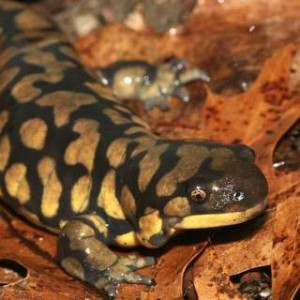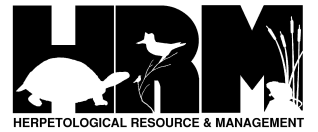Eastern Tiger Salamander
Overview:
Scientific Name: Ambystoma tigrinum tigrinum
Size: 6.7 – 13” (adult length)
Status: Can occur in large populations where suitable breeding habitat is available. May be uncommon to rare elsewhere, especially to the north.
MDNR Wildlife Action Plan Status: Species of Greatest Conservation Need

Habitat:
Occupy woodlands but are less dependent on closed canopy habitats than other Mole Salamanders (Ambystoma spp.). Will inhabitat more open habitats including marshes, grasslands, farmlands, and suburban areas.Must have access to permanent and semipermanent ponds for breeding, preferably with an absence of fishes.
Adult Coloration:
Upper surface of body black to dark brown or gray with irregular yellow, olive brown, or tan blotches and spots scattered over head, back, tail, and sides. Irises of the eyes can be golden. Belly often yellow or olive yellow with some dark pigmentation, but in some may be gray with yellow spots or streaks.
Adult Characteristics:
11-13 costal grooves (grooves between rib-like ridges that run down the sides of the body). Largest terrestrial salamander in Michigan. Adults are robust with a large head and a broad, rounded snout. Males with proportionally longer, more compressed tails and longer, thicker hind legs. During breeding males have a very swollen vent.
Juvenile Characteristics:
Newly transformed juveniles are usually grayish or greenish brown with dull mottling that is lighter than the background. Develop yellow or tan spots with age, which gradually merge into the adult pattern.
Larvae Characteristics:
May be yellowish green or olive with darker blotches down the back, light stripe down each side, and whitish belly. Develop many black dots on upper surfaces or darker pigmentation with light mottling on tail and fins as they grow older. In some populations a cannibalistic form may develop, which has a larger head, flattened snout, and longer teeth.
Species Confused With:
Spotted Salamanders are similar but have rounded yellow spots in two irregular rows as opposed to randomly scattered spots, streaks, or blotches seen in Tiger Salamanders.
References:
- Amphibians and Reptiles of the Great Lakes Region by Jim Harding
- Harding, J.H. and J.A. Holman. 1992. Michigan Frogs, Toads, and Salamanders. MSU Cooperative Extension Service and MSU Museum. Extension Bull. E-2350, 144 pp.
- Ruthven, A. G., H. B. T. Gaige, et al. 1912. The herpetology of Michigan, by Alexander B. Ruthven. Crystal Thompson and Helen Thompson; Memoranda towards a bibliography of the archaeology of Michigan, by Harlan I. Smith; prepared under the direction of Alexander G. Ruthven. Lansing, Mich., Wynkoop Hallenbeck Crawford, State Printers.
- Holman, J. A. 2012. The Amphibians and Reptiles of Michigan: A Quaternary and Recent Faunal Adventure. Detroit, Mich., Wayne State University Press.
- Conant, R., and Collins, J. T. 1998. Reptiles and Amphibians: Eastern, Central North America. Houghton Mifflin Harcourt Press.
